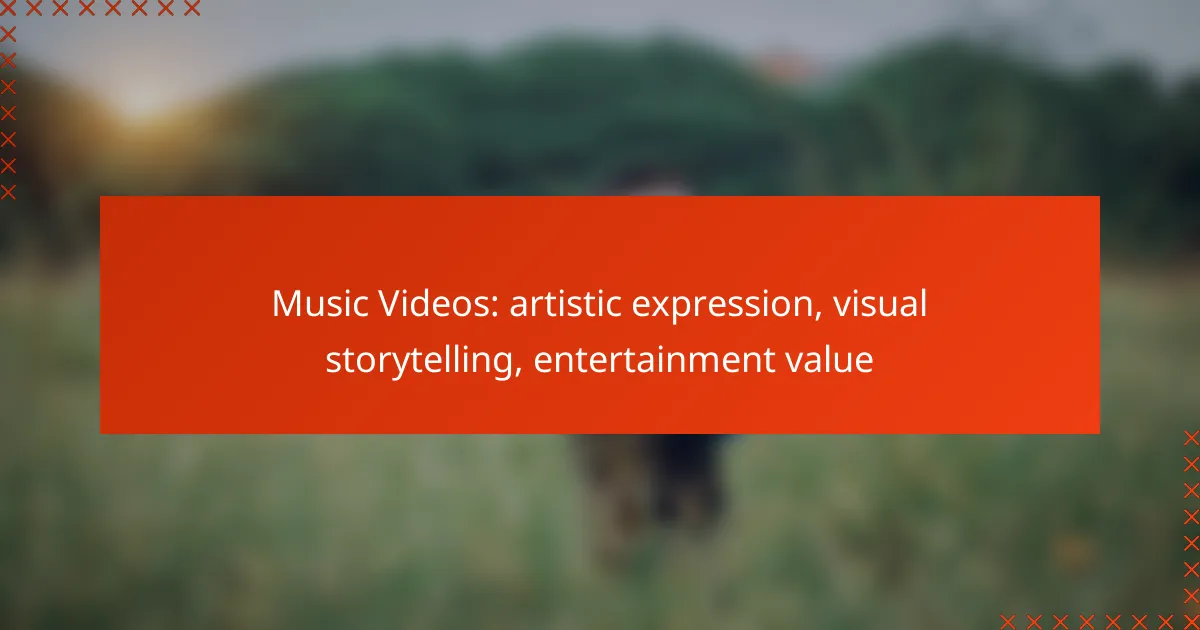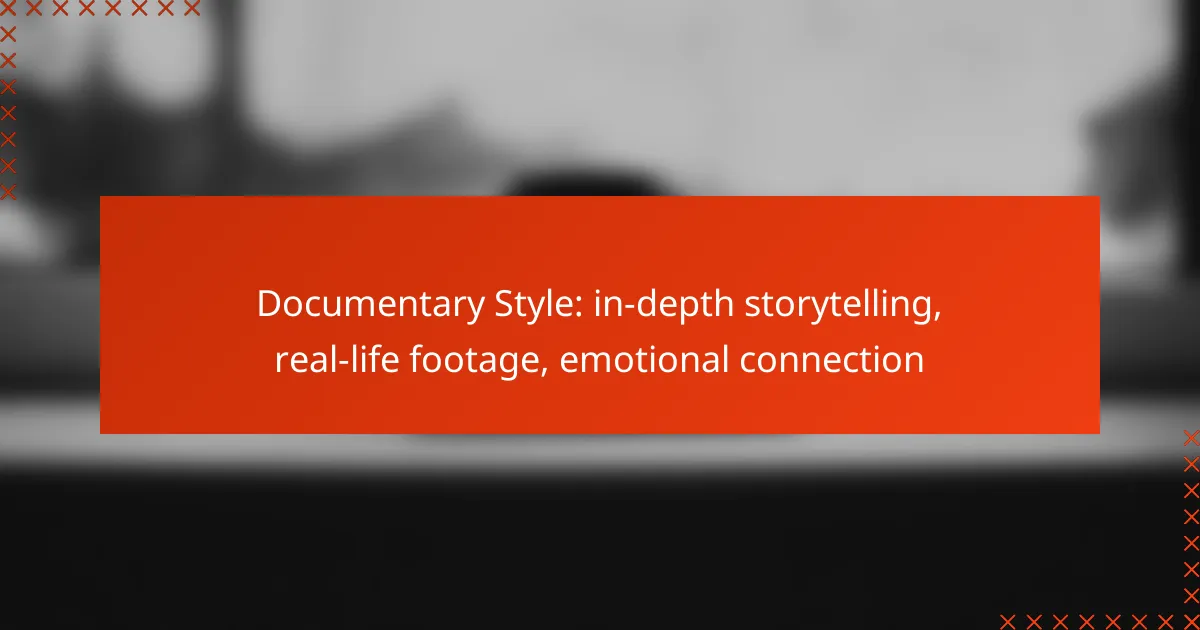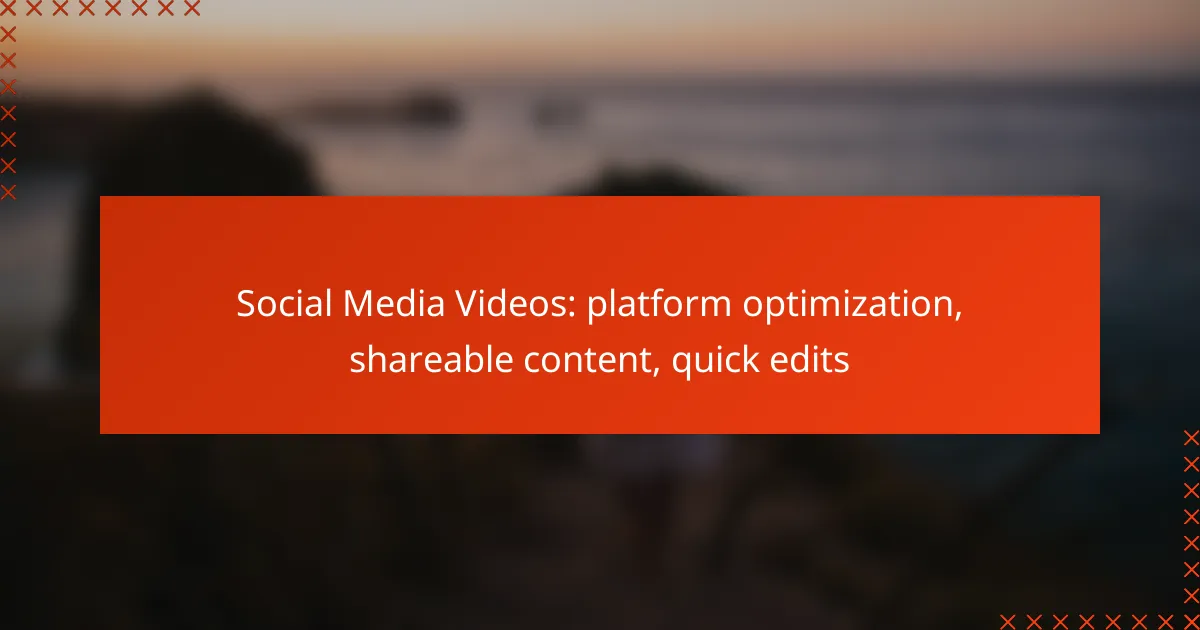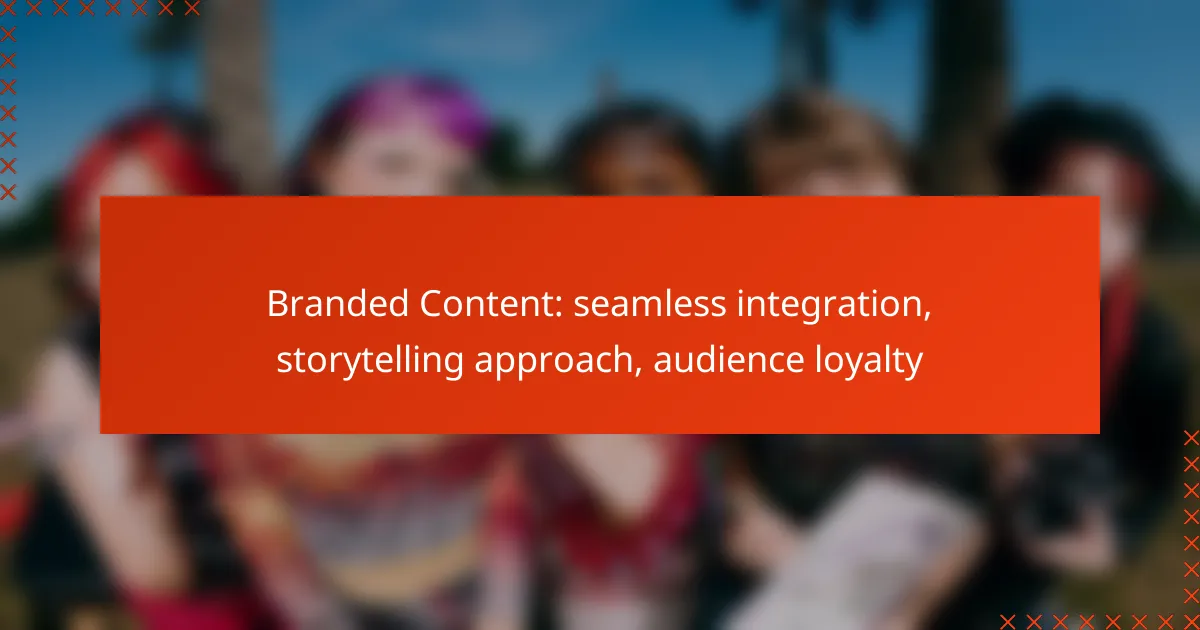Music videos are a dynamic form of artistic expression that merge sound and visuals to craft compelling narratives and emotional experiences. By utilizing innovative storytelling techniques and striking imagery, they enhance the depth of a song while captivating audiences and elevating entertainment value. This unique medium not only conveys deeper meanings but also immerses viewers in a memorable audiovisual journey.
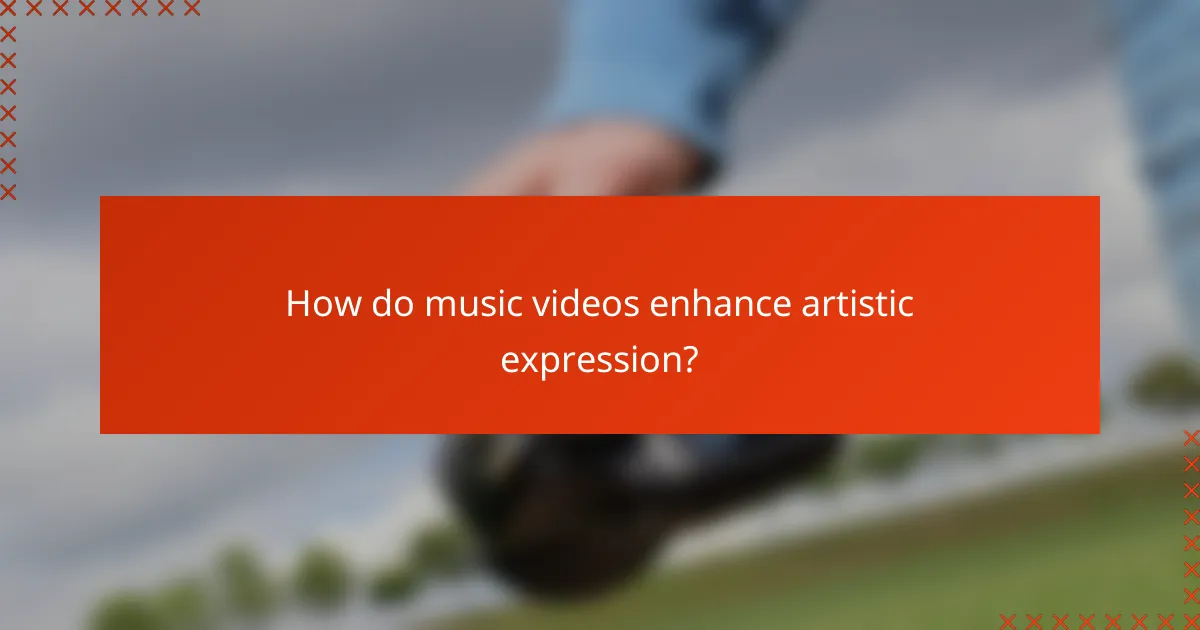
How do music videos enhance artistic expression?
Music videos enhance artistic expression by combining audio and visual elements to create a cohesive narrative or emotional experience. They allow artists to convey deeper meanings and engage viewers through striking imagery, innovative concepts, and unique storytelling techniques.
Visual aesthetics in music videos
Visual aesthetics play a crucial role in music videos, as they set the tone and mood for the viewer. Elements such as color schemes, lighting, and camera angles contribute to the overall artistic vision, often reflecting the song’s themes. For example, a vibrant color palette may evoke feelings of joy, while darker tones can suggest melancholy.
Directors often experiment with different styles, from minimalist approaches to elaborate sets, to create a distinctive look. This visual creativity not only captivates audiences but also reinforces the artist’s brand identity.
Symbolism and themes in storytelling
Symbolism and themes are integral to storytelling in music videos, allowing artists to communicate complex ideas and emotions. Through the use of metaphors, recurring motifs, and visual narratives, these videos can explore topics like love, loss, and social issues. For instance, a music video might use a journey motif to symbolize personal growth or transformation.
Effective storytelling often involves layering these symbols, inviting viewers to interpret the meaning in their own way. This depth can lead to a more engaging experience, encouraging repeated viewings as audiences discover new insights.
Influence of directors like Hype Williams
Directors such as Hype Williams have significantly influenced the landscape of music videos through their innovative techniques and unique visual styles. Known for his use of wide-angle lenses and vibrant colors, Williams has created iconic visuals that have defined the aesthetics of hip-hop and R&B. His work often emphasizes bold imagery that complements the music, enhancing the overall impact.
Collaborating with various artists, Williams has pushed the boundaries of visual storytelling, making music videos an essential part of an artist’s promotional strategy. His influence has inspired a new generation of directors to explore creative possibilities, ensuring that music videos remain a vital form of artistic expression.
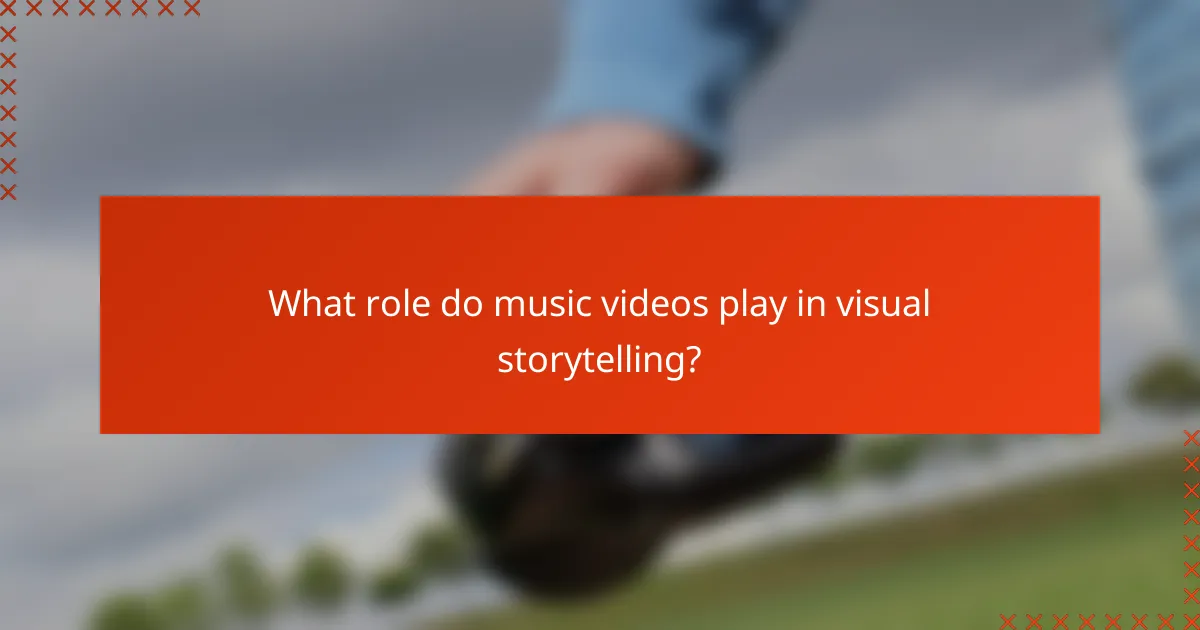
What role do music videos play in visual storytelling?
Music videos serve as a powerful medium for visual storytelling, enhancing the narrative and emotional depth of a song. They combine music with imagery to create a cohesive experience that can evoke feelings, convey messages, and engage audiences in unique ways.
Narrative structures in popular music videos
Many popular music videos utilize clear narrative structures to tell a story that complements the song’s lyrics. Common formats include linear storytelling, where events unfold in a chronological order, and non-linear storytelling, which may involve flashbacks or parallel narratives. These structures help to create a more immersive experience for viewers.
For instance, a music video might depict a romantic relationship’s rise and fall, mirroring the song’s themes. This alignment between the visual and auditory elements enhances the overall impact and memorability of the piece.
Case studies of iconic music videos
Iconic music videos like Michael Jackson’s “Thriller” and Beyoncé’s “Formation” exemplify the art of visual storytelling. “Thriller” combines horror elements with dance, creating a narrative that captivates viewers while showcasing Jackson’s performance skills. This video set a standard for storytelling in music videos, blending choreography with a compelling plot.
Beyoncé’s “Formation” addresses social issues and personal identity, using powerful imagery to convey a message of empowerment. The video not only entertains but also sparks conversations about race and culture, demonstrating how music videos can influence societal narratives.
Impact of cinematography on storytelling
Cinematography plays a crucial role in shaping the storytelling of music videos. Techniques such as camera angles, lighting, and color grading can significantly affect the mood and tone of the narrative. For example, low lighting and close-up shots can create an intimate atmosphere, while vibrant colors and wide shots may evoke joy and celebration.
Effective use of cinematography can enhance the emotional resonance of a song, making the visuals more impactful. Filmmakers should consider how different visual styles align with the song’s message to create a cohesive storytelling experience that resonates with viewers.

How do music videos contribute to entertainment value?
Music videos enhance entertainment value by combining audio and visual elements to create a compelling narrative or artistic expression. They engage viewers through storytelling, aesthetics, and emotional resonance, making the music experience more immersive and memorable.
Engagement metrics for music videos
Engagement metrics for music videos include views, likes, shares, and comments, which indicate how well a video resonates with its audience. High engagement often correlates with a video’s entertainment value, as viewers are more likely to interact with content that captivates them. Tracking these metrics can help artists and producers refine their strategies for future releases.
Platforms like YouTube provide detailed analytics, allowing creators to assess viewer retention and demographic information. This data can guide decisions on marketing and content creation, ensuring that future videos align with audience preferences.
Fan interaction and community building
Music videos foster fan interaction and community building by encouraging viewers to share their thoughts and experiences related to the content. Comment sections and social media platforms serve as spaces for fans to connect, discuss interpretations, and share their own creative responses to the video. This interaction enhances the overall entertainment value by creating a sense of belonging among fans.
Artists often engage with their audience through live streams or Q&A sessions, further solidifying community ties. Encouraging fan-generated content, such as dance challenges or covers, can also amplify engagement and deepen connections.
Examples of viral music videos
Viral music videos often exhibit unique storytelling, catchy hooks, or memorable visuals that resonate with a broad audience. For instance, “Gangnam Style” by PSY became a global phenomenon due to its catchy beat and humorous dance moves, leading to billions of views. Similarly, “Despacito” by Luis Fonsi and Daddy Yankee captivated audiences with its infectious rhythm and vibrant visuals.
These examples highlight how creativity and cultural relevance can propel a music video into viral status. Artists should consider current trends and audience interests when developing their videos to increase the likelihood of achieving similar success.
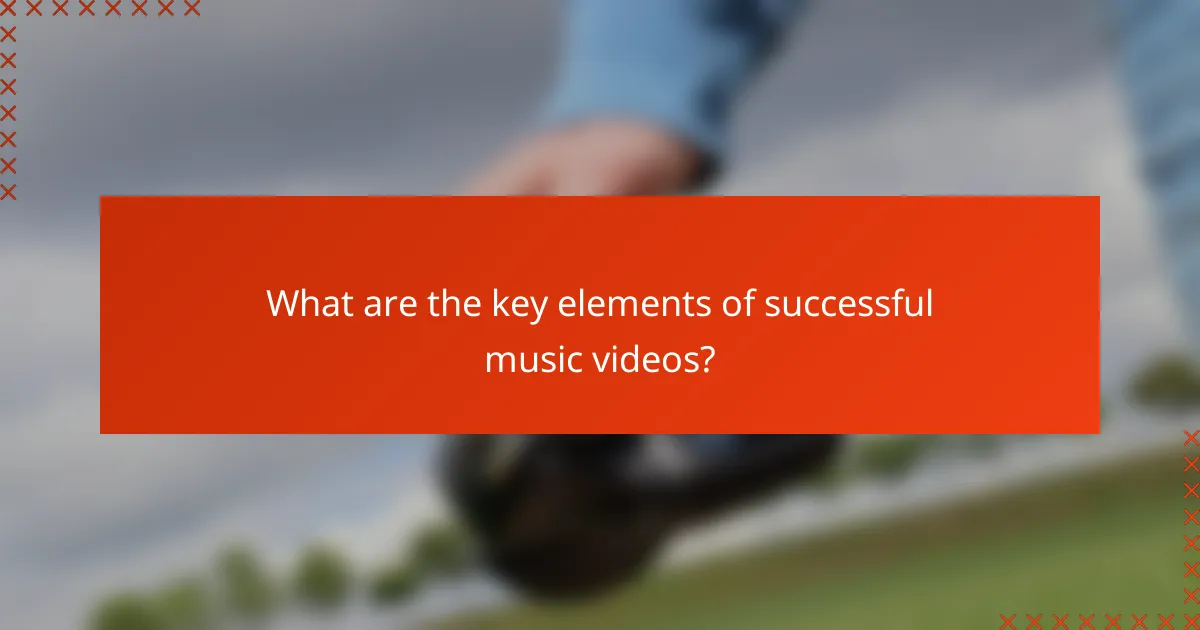
What are the key elements of successful music videos?
Successful music videos combine artistic expression, visual storytelling, and entertainment value to engage viewers. Key elements include high production quality, effective collaboration between artists and visual creators, and a clear narrative that complements the song’s themes.
Production quality and budget considerations
Production quality significantly impacts a music video’s success. A higher budget often allows for better equipment, locations, and post-production effects, which can enhance the overall visual appeal. However, effective storytelling can still shine through lower-budget productions if creativity is prioritized.
When planning a music video, consider allocating funds for essential aspects such as filming equipment, set design, and editing. A budget range of a few thousand to several hundred thousand dollars can be typical, depending on the artist’s goals and the video’s complexity.
Collaboration between artists and visual creators
Collaboration is crucial for creating a cohesive music video that reflects the artist’s vision. Artists should communicate their ideas clearly to directors and visual creators, ensuring that the narrative aligns with the song’s message and tone. This partnership can lead to innovative concepts and memorable visuals.
Establishing a collaborative environment involves regular meetings and brainstorming sessions. Artists can benefit from involving visual creators early in the process, allowing for a seamless integration of music and visuals that enhances the storytelling aspect of the video.
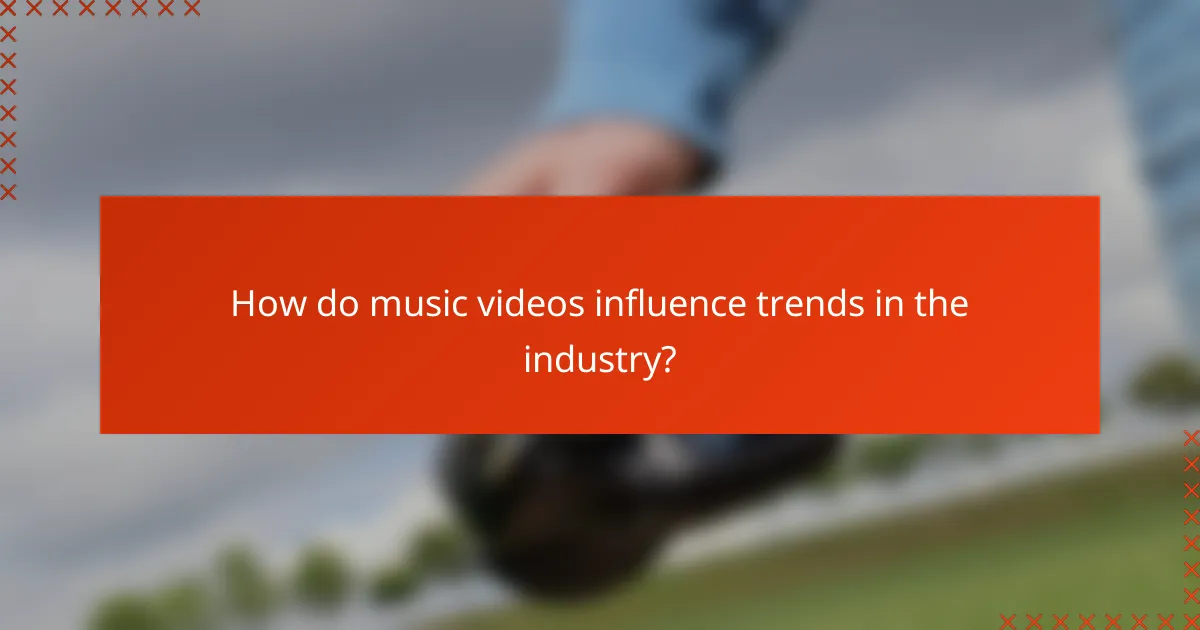
How do music videos influence trends in the industry?
Music videos significantly shape trends in the music industry by introducing new visual styles and storytelling techniques that resonate with audiences. They serve as a platform for artists to express their creativity and connect with fans, often leading to shifts in musical genres and marketing strategies.
Emerging styles and genres in music videos
Music videos often showcase emerging styles and genres, influencing both artists and viewers. For instance, the rise of hip-hop has brought about a distinct visual language characterized by bold aesthetics and urban settings. Similarly, genres like K-pop have popularized vibrant colors and intricate choreography, setting new standards for visual storytelling.
Artists frequently experiment with innovative techniques, such as animation or virtual reality, to create unique experiences. This experimentation can lead to the birth of new sub-genres, as seen with the fusion of electronic music and visual art in recent years.
Impact of social media on music video distribution
Social media has transformed how music videos are distributed and consumed, allowing artists to reach global audiences instantly. Platforms like YouTube, Instagram, and TikTok enable quick sharing and viral trends, significantly impacting an artist’s visibility and popularity.
Short-form video content is particularly effective in engaging viewers, often leading to increased streaming numbers and fan interaction. Artists should leverage these platforms by creating shareable content and engaging directly with their audience to maximize their reach and influence in the industry.
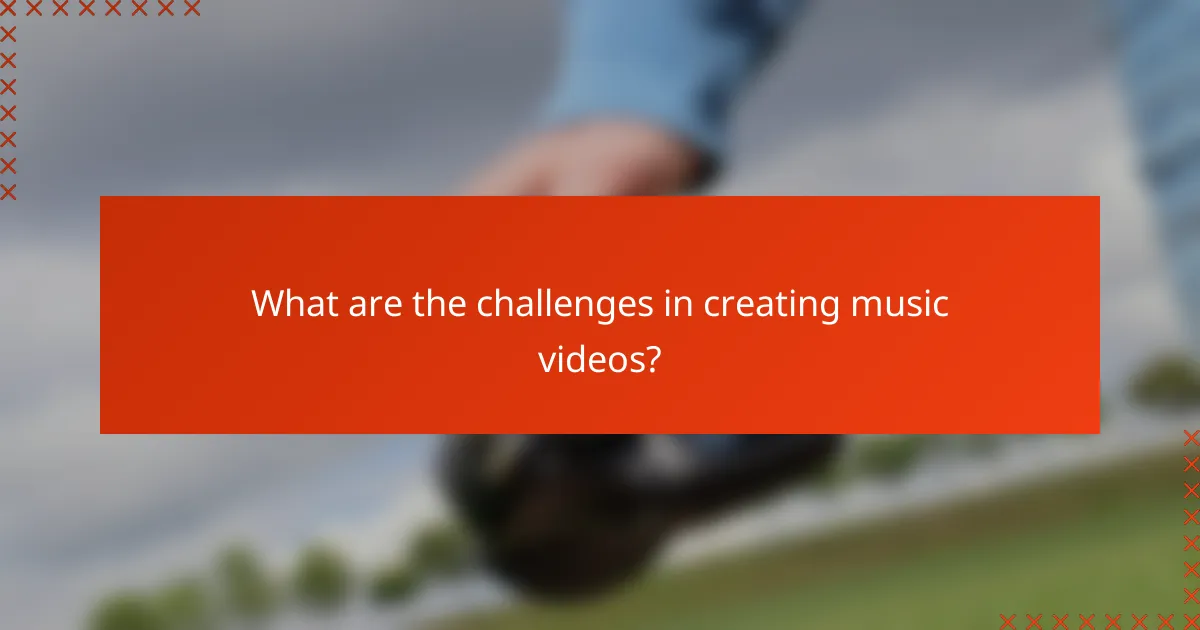
What are the challenges in creating music videos?
Creating music videos involves several challenges, including budget limitations, funding sources, and the need to balance artistic expression with commercial viability. These factors can significantly impact the production quality and overall success of the video.
Budget constraints and funding sources
Budget constraints are a primary challenge in music video production. Costs can vary widely, typically ranging from a few thousand to several hundred thousand dollars, depending on the complexity of the concept and the talent involved.
Funding sources for music videos often include record labels, crowdfunding, and sponsorships. Artists should explore multiple avenues to secure financing, as relying solely on one source can limit creative possibilities.
Balancing artistic vision with commercial demands
Balancing artistic vision with commercial demands is crucial for a successful music video. While artists may have a unique concept in mind, they must also consider the preferences of their target audience and the expectations of their label.
To achieve this balance, artists can start by clearly defining their artistic goals and then identifying elements that can be adjusted to meet commercial needs. Collaborating with experienced directors and producers can help navigate these trade-offs effectively.
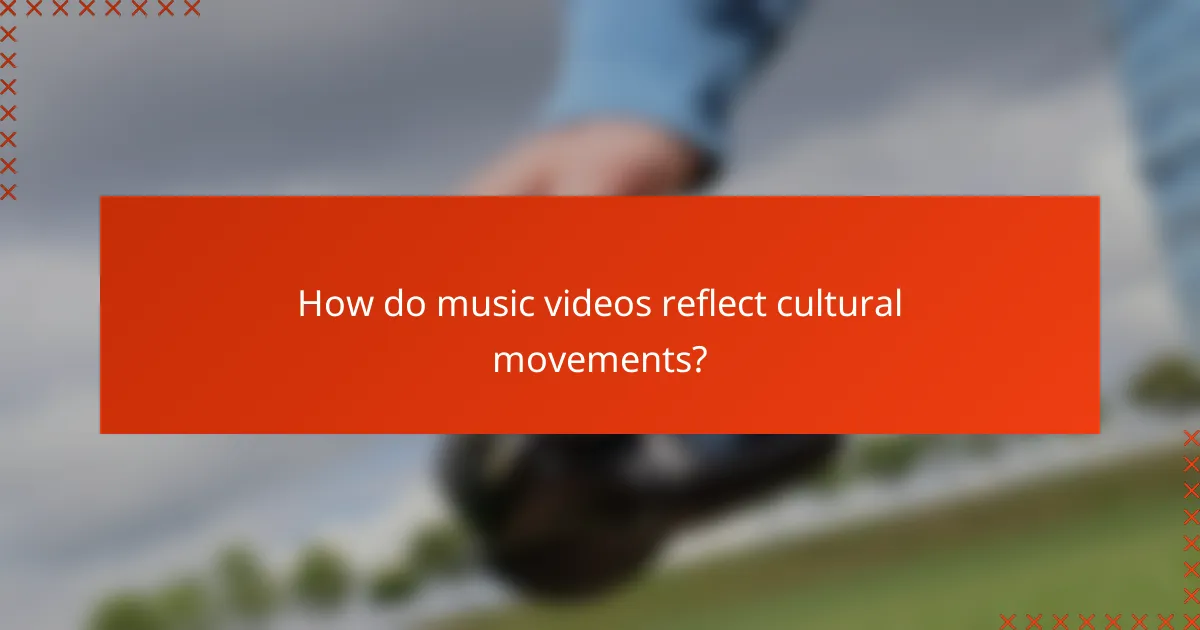
How do music videos reflect cultural movements?
Music videos serve as a powerful medium for expressing and reflecting cultural movements, often capturing the zeitgeist of their time. They convey social messages, challenge norms, and celebrate diversity, making them a vital part of contemporary culture.
Representation of social issues in music videos
Music videos frequently address pressing social issues such as racism, gender equality, and mental health. For instance, videos like Childish Gambino’s “This Is America” highlight systemic racism and gun violence, prompting viewers to engage with these topics critically.
By using visual storytelling, artists can evoke strong emotional responses and raise awareness about societal challenges. This representation not only entertains but also educates audiences, encouraging dialogue and action.
Historical context of music videos in different eras
The evolution of music videos reflects significant cultural shifts over the decades. In the 1980s, the rise of MTV transformed music promotion, with artists like Michael Jackson and Madonna using videos to enhance their artistic expression and reach wider audiences.
In the 1990s and 2000s, the advent of the internet changed how music videos were distributed, allowing for greater creativity and experimentation. Today, platforms like YouTube enable artists to connect directly with fans, further influencing cultural movements through innovative visual narratives.
